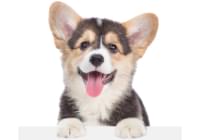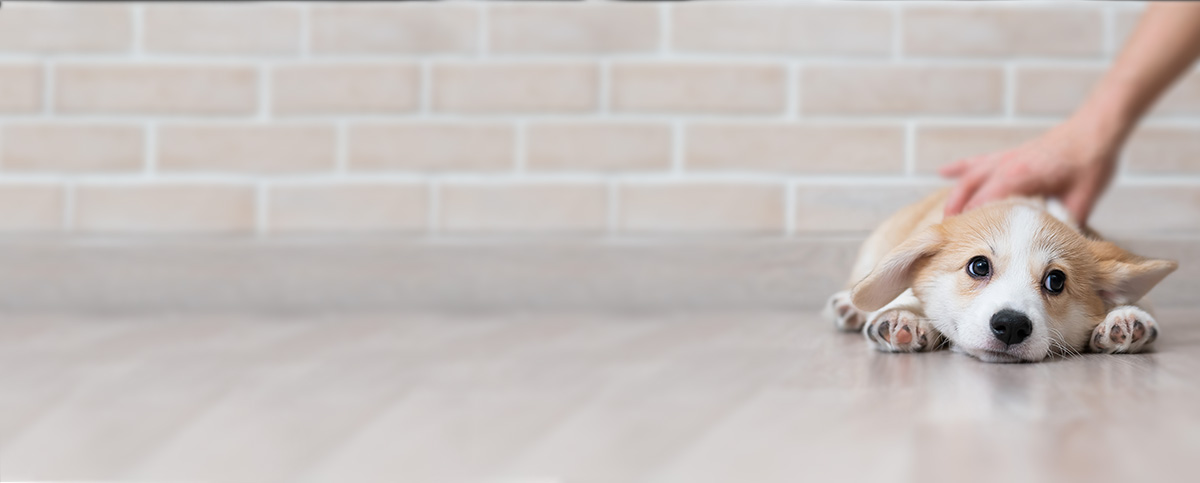Disc Disease
Spinal Anatomy
The backbone or spine is made up of many small bones (vertebrae) that fit together in a column. They house and protect the spinal cord, and the multiple joints allow for flexibility and movement. Between each of these vertebrae is a cushion called a disc. The disc consists of a tough outer shell (annulus fibrosis) and a soft inner cushion (nucleus pulposis).
Types of Disc Disease
There are three main types of disc problems.
- Type I disc disease occurs when the nucleus pulposis stops being soft and becomes calcified. If pressure is put on that disc, it can rupture out the annulus fibrosis and compress the spinal cord. This generally occurs in younger dogs small breed dogs, especially those with short legs and long backs. Although it is common in younger dogs, it can occur at any age and can affect more than one disc. Commonly affected breeds include Dachshunds, Chihuahuas, French Bulldogs, Boston Terriers, Pugs, Cocker Spaniels, Bulldogs, Shih-Tzus, and Pekingese. Dachshunds often develop calcified discs at a very young age, or are even born with calcified discs. While a jump or fall may initiate the signs, that jump could not have caused issues if there was not a calcified disc present to start with.
- Type II disc disease is a slower degenerative process where the annulus fibrosis fibers become weak and gradually put pressure on the spinal cord. It is more common in older large breed dogs (though it can occur at any age) such as German Shepherds, Labradors, and Dobermans.
- Fibrocartilaginous emboli (FCE) occur when nucleus pulposis material gets into the blood vessels and cut off blood supply to the spinal column. These occur in any breed, although 50% do occur in giant breed dogs. Chondrodystrophic dogs are also susceptible to FCE. These are non-painful.
Signs of Disc Disease
Disc disease results in spinal cord damage, but there are different levels of damage, and different signs depending on where the disc disease occurs. If the disc problem occurs in the neck, there can be neurologic signs in all four feet. If the disc problem occurs in the lower thoracic/upper lumber (at the end of the ribs; most common in Type I), the hind limbs and bladder/bowel function are affected.
The first spinal function to be lost is proprioception. This is the animal's ability to know where their feet/body is. Signs of proprioception loss are stumbling, swaying, and scuffing of the feet. The next spinal function to be affected is motor, which is the ability to move. When motor is affected the animal cannot walk with the affected limbs.
The final two spinal functions are superficial and deep pain. Deep pain is tested by a strong toe pinch. Loss of deep pain sensation is a surgical emergency because it indicates severe spinal cord damage. Once deep pain is lost, even with prompt (within 24 hours) surgery, there is only a 50% chance of regaining the ability to walk.
Type I and Type II disc disease are generally very painful. Depending on the degree of spinal cord damage, the animal can lose the ability to control bowel and bladder function. Owners have to manually express the bladder of an animal that cannot control their bladder. This is done by pressing on the lower abdomen to put pressure on the bladder.
Diagnosis
Disc disease can be suspected based on physical examination, and often general location of the affected disc can be determined from the exam and a neurologic test. However, there are other things which can cause similar signs (tumors, trauma, infection, spondylosis), so it is ideal to take x-rays (radiographs) of the suspected area. Sometimes calcified discs can be seen on radiographs, but in some breeds of dogs with early disc calcification, a calcified disc may not actually indicate the location. Ruptured discs can be suspected from radiographs, but more advanced imaging is required to confirm location.
If surgery is being considered, or there is concern about other causes, further diagnostics such as myelography (injection of dye around the spinal cord), MRI, and CT are generally performed at referral and specialty clinics to localize the lesion.
General Rules for Treatment
- If the dog cannot walk, surgery affords the best chance at recovery.
- If the dog can walk, medical (non-surgical) treatment is a reasonable choice but this also depends on how much pain the patient isin, how long-standing signs are, and what sort of treatments have been unsuccessful in the past.
- The longer the neurologic deficits have been going on, the poorer the results of treatment.
- If the dog cannot walk but deep pain is present in the limbs, there is an 80-85% chance of walking again with surgery.
- If the dog cannot walk and has no deep pain response, surgery in less than 24 hours means a 50% chance of walking again. Surgery within24-48 hours of loss of deep pain means a 25% chance of walking again. After 48 hours, surgery is unlikely to help.
- If the dog cannot walk, medical management may still have success though surgery is definitely more likely to yield success.
Treatment - Treatment for disc disease is generally divided into surgical and non-surgical options.
Non-surgical treatments
- Traditional conservative treatment for mildly affected dogs includes 2-3 weeks of strict rest, anti-inflammatory medications, and pain medications as needed. For severe pain, muscle relaxers can be used (methocarbamol) but if they are used, it is very important that your pet be cage rested. Relaxing the muscles can allow the disc to protrude further and cause progression of neurologic signs if there is a lot of movement. Massage and warm compresses can also help relieve back and neck pain. Use warm compresses for 10-15 minutes at a time, 2-5times daily, ensuring they are not too hot.
- B Vitamin injections can help nerve healing and are often used weekly during the initial phase. In addition joint supplements maybe used during this time to help with inflammation and joint health. See preventatives for a description of supplements often used.
- Laser therapy is another option for pain control. Laser therapy speeds healing, decreases inflammation, and helps control pain. For acute conditions, therapy is done M, W, F for 2-3 weeks.
- Alternative treatments can be very helpful in mild cases of disc disease or even in severe cases where surgery is not an option.
- Chiropractic adjustments affect nervous system function by targeting joints in the spinal cord that are not moving in their full range of motion. An adjustment (thrust) into the joint restores motion and allows the nerves going to the joint and surrounding tissues to function optimally. This promotes healing and provides pain relief. Chiropractic adjustments are generally done every 1-2 weeks in acute cases for 3 treatments and then response in evaluated. Especially in Type I dogs, recurrence of problems is likely, and chiropractic care can help prevent further issues. Chiropractic care may be an option to help avoid surgery for some patients. In addition chiropractic care carries few risk and can easily be combined with other treatment options. It works especially well in concert with acupuncture.
- Acupuncture is an effective and safe neurophysiologic intervention. Acupuncture points are areas of concentrated nerve endings and immune system cells. Stimulation of these points by various methods (needles, vitamin injections, laser, electo-acupuncture) activates pain-associated brainstem regions. Like chiropractic care, it promotes healing and provides pain control by improving nervous system function. These two modalities are well-suited to use together.
- Physical Therapy - As mentioned previously, physical therapy can increase the likelihood of a positive result in disc disease. It is a positive prognostic indicator for FCE, but speeds healing and return to normal mobility no matter what type of disc injury. We recommend you set up an appointment to develop the best physical therapy plan for your pet. We refer patients regularly to Dr Anna Tackett in Georgetown for physical therapy. She works with patients on exercises and can develop a home care plan for owners.
- Hyperbaric Oxygen Treatment - HBOT is the delivery of 100% oxygen under pressure in a hyperbaric chamber. Forcing oxygen into tissues can speed healing and significantly reduce recovery times as well as improve outcomes for many diseases, including disc disease.
- All Creatures Hyperbaric is a local facility that provide HBOT.
Surgerical Treatments
Spinal surgery is highly invasive, expensive, and does have the potential for poor outcome as well as a good outcome. It is generally performed on an emergency basis and most often at a specialty or referral center. Post-surgery most pets require intensive nursing care and physical therapy. An MRI or CT scan is done to localize the lesion, and then the pet usually goes straight to surgery without being woken up from anesthesia. There are various procedures for spinal surgery. Some involve removing disc material from around the spinal cord, and some involve long term pressure relief of the spinal canal. Examples of spinal surgery include hemilaminectomy, dorsal laminectomy, pediculectomy, ventral slot, and fenestration.
Recovery expectations
It can take 4 weeks to see a response to treatment and at least ten weeks to see full results. Generally the recovery that has happened by ten weeks is what can be expected.
Risk
- Permanent paralysis/paresis - as previously mentioned, the more severe the spinal damage, the less chance of recovering normal function. In some cases this means dogs may be left without the use of hind legs. Many dogs will function well in carts that support their back legs and allow them to get around using their front legs. Once a cart is used, if it is not meant to be permanent, it is critical that physical therapy be done to maintain muscles in the non-functioning limbs. Dogs who are permanently in carts can have a wonderful quality of life with some good maintenance and nursing care. Google you tube videos of Dachshunds in carts to see these happy and adaptive dogs functioning in carts.
- Ascending/Descending myelomalacia – 10% of deep pain negative dogs have spinal cord damage that progresses and moves forward. Basically the spinal cord disintegrates until it reaches the high cervical level that controls breathing and the dog suffocates. If at any time during treatment or post-operatively ascending signs are noted, this may be a concern. There is no treatment for myelomalacia, and generally euthanasia is recommended to prevent suffering. Sometimes the surgeon can see indicators for it during surgery. It is usually conformed by progressing signs within three days of surgery.
Prevention
Joint supplements may help promote disc health and can be used as preventative measures.
- Glucosamine/Chondroitin (Dasuquin Advanced is the product we recommend) – decreases inflammation and can help prevent further disc calcification
- PSGAG shots – can improve joint fluid and prevent further formation on arthritis that can be involved in some disc disease
- Movoflex– anti-oxidant and egg shell supplement that helps promote joint fluid health
- Antinol – joint targeted mussel oil that helps decrease inflammation
Regular chiropractic adjustments can help prevent further issues or decrease their severity. Each patient is different, but generally once monthly is a good preventative schedule.
Consider pet stairs or limiting animals jumping up and down off furniture. As mentioned previously, a jump isn’t the primary cause, but just a result of a calcified disc, however, reasonable restrictions may prevent return of clinical signs.
Especially in cases of cervical disc disease, body harnesses are preferred to collars and leashes that pull on the dog’s neck.
Cookies on this website are used to both support the function and performance of the site, and also for marketing purposes, including personalizing content and tailoring advertising to your interests. To manage marketing cookies on this website, please select the button that indicates your preferences. More information can be found in our privacy policy here.
We've upgraded our online store!
Ordering your pet's favorite food and medicine is now easier than ever.
Order Food & Meds
Quick & Easy Registration

Please use the phone number and email you currently use for hospital communications to link your account!
Linked Pet Records & Rx

Your pet's prescriptions and records will be waiting for you!
Pawsome
Savings!

AutoShip discounts, promotions on your favorite products and more!


